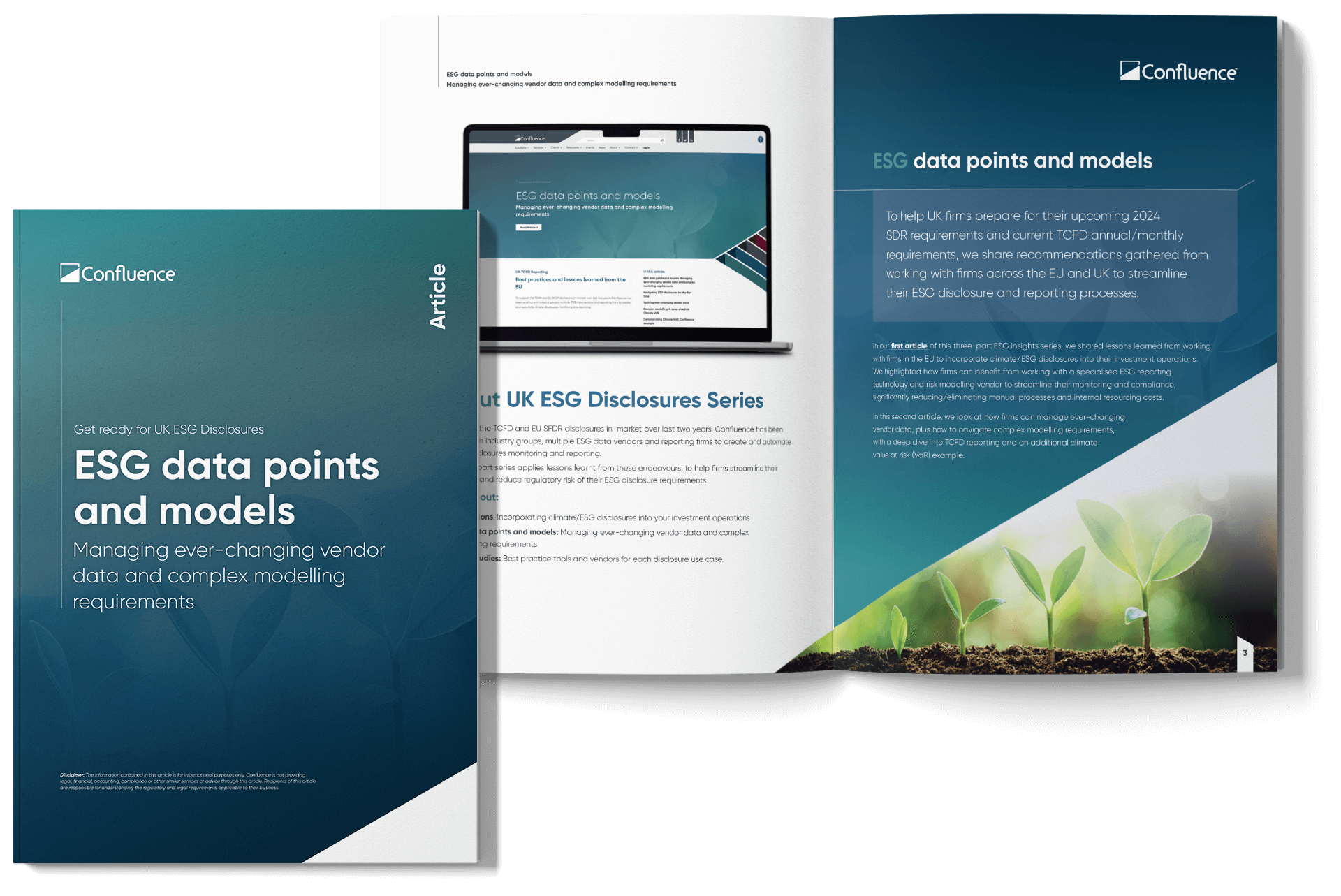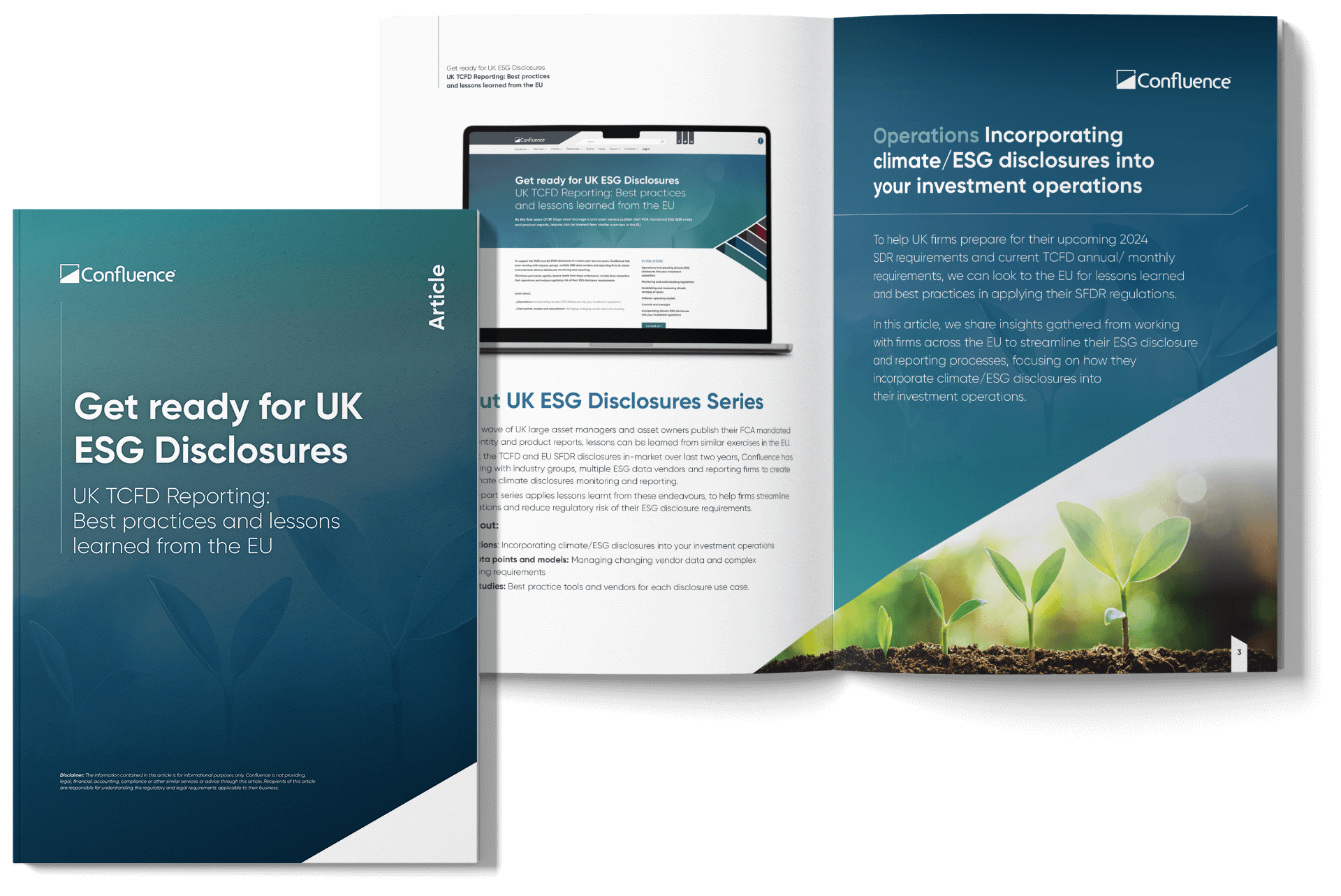Operations Incorporating climate/ESG disclosures into your investment operations
UK TCFD Reporting
Best practices and lessons learned from the EU
To support the TCFD and EU SFDR disclosures in-market over last two years, Confluence has been working with industry groups, multiple ESG data vendors and reporting firms to create and automate climate disclosures monitoring and reporting.
This three-part series applies lessons learnt from these endeavours, to help firms streamline their operations and reduce regulatory risk of their ESG disclosure requirements.
Discover the articles in this series:

ESG data points and models
Managing changing vendor data and complex modelling requirements

Operations
Incorporating climate/ESG disclosures into your investment operations
Operations Incorporating climate/ ESG disclosures
To help UK firms prepare for their upcoming 2024 SDR requirements and current TCFD annual/monthly requirements, we can look to the EU for lessons learned and best practices in applying their SFDR regulations.
In this article, we share insights gathered from working with firms across the EU to streamline their ESG disclosure and reporting processes, focusing on how they incorporate climate/ESG disclosures into their investment operations.
Monitoring and understanding regulations
While some EU larger firms deploy dedicated resources, most firms rely on industry bodies, outside consultants and engagement with regulators (who typically publish draft regulation for industry feedback), to understand what’s coming. This is also the case in the UK.
A good starting point for regulatory information in the UK is the Financial Conduct Authority’s FCA Handbook. The current TCFD reporting, entity and product disclosure requirements are outlined according to the following schedule:
- 30 June 2023: large asset managers with >£50 billion AUM and asset owners with >£25 billion AUM or administration
- 30 June 2024: smaller asset managers with £5-£50 billion AUM and asset owners with £5-£25 billion AUM or administration
The 2024 SDR regulations are yet to be published.
Firms can rely on industry bodies; however, we recommend firms also work with a specialist ESG reporting vendor to reduce/remove manual processes, and to provide expert guidance on regulations compliance to reduce complexity and mitigate risk.
Establishing and measuring climate strategy progress
- Board oversight and their management role in climate related issues
- Climate related corporate strategy
- Processes for identifying, managing and integrating climate into overall risk management program
- Metrics and targets used to assess climate risk.
Firms need to establish and measure a climate strategy, with board oversight and KPIs to track and explain progress. In fact, employing either EU SFDR or UK SDR policies implies committing to ongoing data tracking to collect and monitor data across all portfolios’ companies and to reduce ambiguities or overcommitments in pre-contractual disclosures, in a clear, measurable and achievable way.
Different operating models
Data and technology vendors are chosen to support these operations, with an eye on upcoming requirements (such as the 2024 UK SDR disclosures) or other jurisdictions where the firm conducts business.
Finally, some firms choose to outsource this process partially through a service provider or entirely through a managed service. Whichever operational model firms choose, they’re liable in the eyes of the regulator and need to ensure appropriate oversight and governance to ensure regulatory compliance.
Controls and oversight
In addition to board level governance ensuring disclosures are published in a timely and orderly manner, firms need a quality assurance process in place to ensure disclosures are both accurate and correctly tracking their stated climate strategy and goals.
A key takeaway from EU SFDR; clear communication is paramount for both investors and regulators, particularly during the investment phase. Funds may be holding substantial cash reserves and the preliminary gaps across several ESG data points may be seen as an additional opportunity to move investments and operational processes accordingly going forward, keeping focus on well-established and proven sustainable issuers.
An essential element of controls and oversight management is detailing how funds meet environmental (or social) characteristics, and any additional sustainability objectives. This can be as simple as tracking, for example, a time series of carbon emissions or density. A more sophisticated approach can measure and attribute carbon performance or climate adjusted risks, providing forecasts of forward-looking downsides associated with both physical and transition risks, including and not limited to, exposure to climate changes and carbon earnings at risk.
Third party technology and risk modelling vendors can support firms in reducing the complexity and manual resourcing of controls and oversight. Firms are empowered to protect investments and optimise performance, whilst reaching their sustainability goals through streamlined processes.
Incorporating climate/ESG disclosures into your investment operations
Firms can benefit from working with a specialised ESG reporting technology and risk modelling vendor to streamline their monitoring and compliance, significantly reducing/eliminating manual processes and internal resourcing costs. When choosing a vendor, look for one with specialised ESG reporting technology, data specific to TCFD and SFDR/SDR regulations, a wide coverage of multi-asset classes, templated and flexible reporting, controls integration, market risk/ESG stress testing and knowledgeable ESG regulatory experts.
Accurate, timely disclosures delivered with minimal complexity and costs, whilst keeping up to date with regulatory requirements and monitoring climate strategy progress, are possible with the right ESG reporting technology and risk modelling support. As UK firms prepare for their TCFD requirements and get ready for the announcement of the 2024 SDR regulations, forward planning and embedding an ongoing regulatory change program into investment operations is essential.